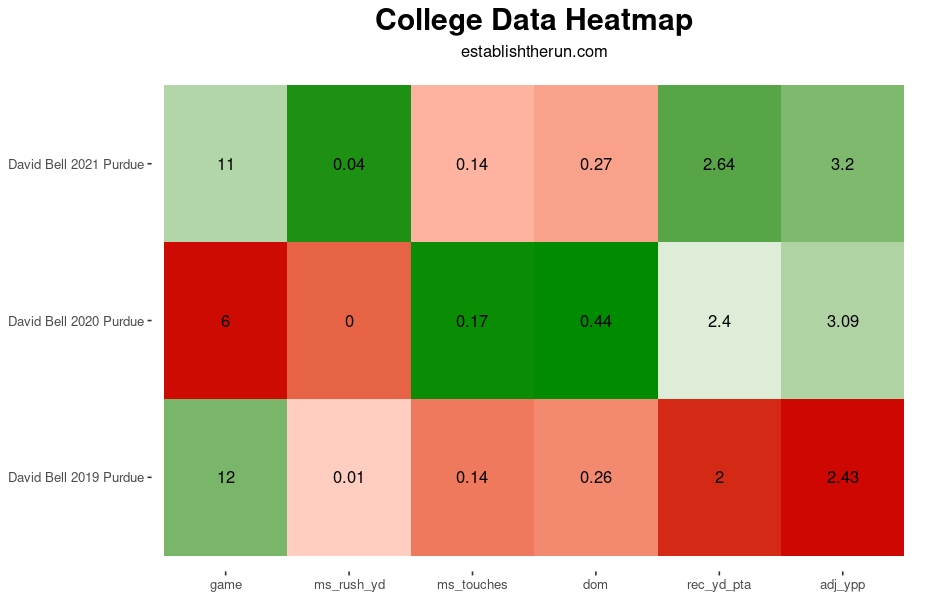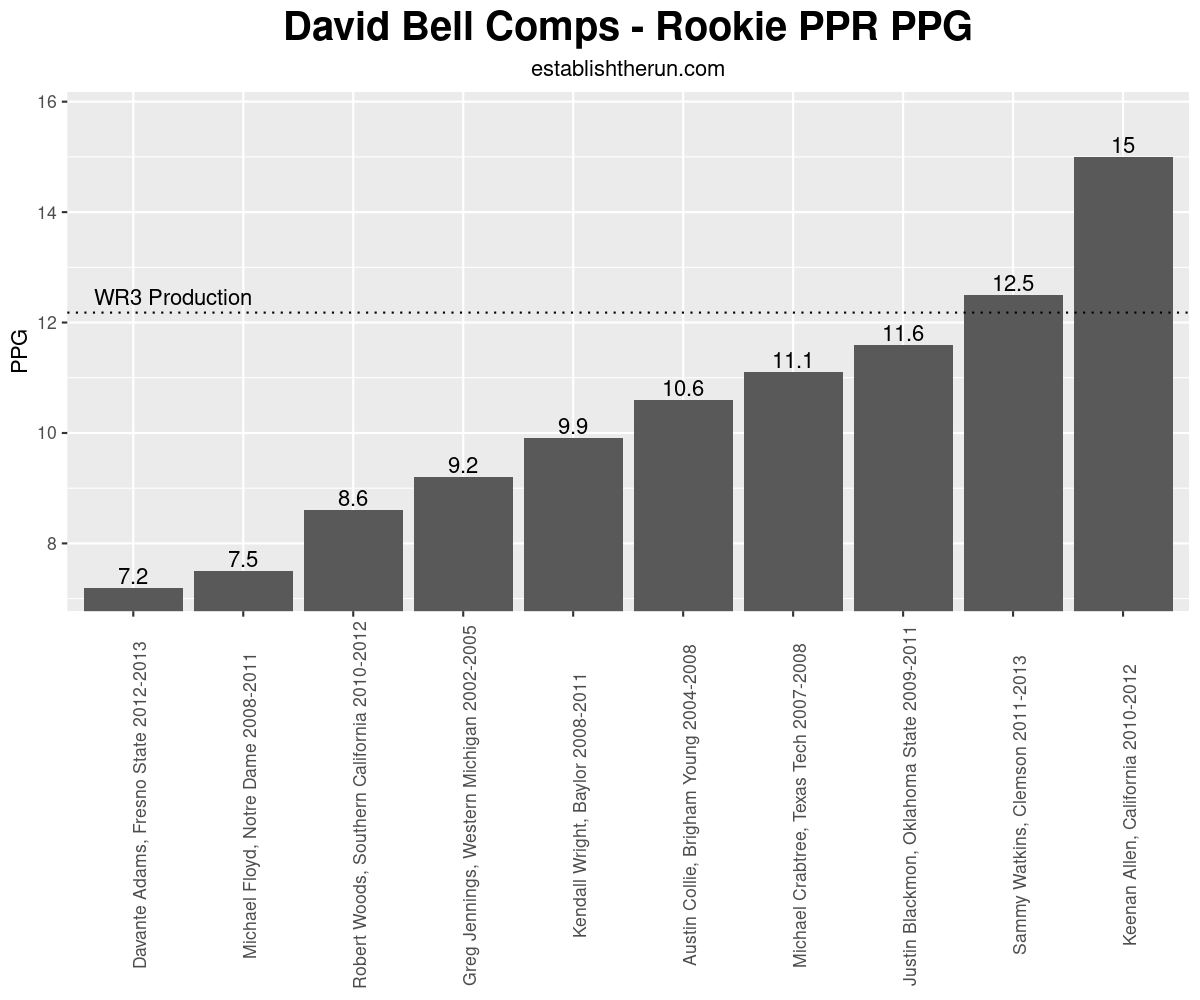Dynasty Outlook
March 6
Bell weighed in heavier than expected, but did not test well athletically, matching what the scouts had assumed entering the Combine. However, even with a draft position bump down, Bell’s top two comps are Davante Adams and Keenan Allen. His statistical profile is still extremely good, and we remain bullish on him for fantasy.
Feb. 22
Bell is someone we like as a pick in the middle to late portion of the first round for rookie drafts, and is WR29 in our overall dynasty ranks. While he is likely to lack the first-round draft capital of the other prospects covered so far, Bell has comps that tell us he is a fairly safe dynasty asset. Safety alone would not have him ranking so highly, so it is important to note his ceiling includes some elite PPR WRs. The scouts note his potential lack of athleticism, but that could matter more for his draft capital than his NFL production. Some of his comparable players also lacked high-end tested speed, but were able to produce WR1 numbers through other avenues.
Profile Summary
David Bell is one of the more interesting wide receiver evaluations for this class. Statistically, he looks the part. Bell broke out in his second collegiate season, and proved that he could hang with NFL talent while at Purdue. However, the scouts do not appear to be as keen on his abilities — particularly as it relates to athleticism, but his comps paint the picture of someone who is a high-floor player with the upside to be a team’s top target. Bell looks like a Day 2 pick for the NFL Draft.
Vitals
Age (as of 12/31/21) — 21.1
Experience — 3 years
Height — 72.875 inches
Weight — 212 pounds
Hand Size — 9.25 inches
Arm Length — 31.875 inches
Wingspan — 76.625 inches
Forty — 4.65 seconds
Vertical — 33 inches
Broad — 118 inches
3-Cone — 7.14 seconds
Shuttle — 4.57 seconds
By the Numbers

Bell has been a key piece of the Purdue offense since his true freshman season. He managed to top 1,000 receiving yards (28%) while playing alongside Rondale Moore for three games, and Super Bowl showdown legend, Brycen Hopkins. But Bell’s early success shouldn’t be attributed to the absence of Moore alone for much of the season. In the three games the pair played together, Bell outproduced the top-50 pick:
Bell — 304 yards (32%), 4 TDs (50%)
Moore — 270 yards (29%), 0 TDs (0%)
This is a small sample, so it isn’t necessarily an indicator that Bell is better than Moore, but it is incredibly encouraging.
Bell was not active in the return game, but he did make some plays as a rusher. His adjusted yards per play were top five in this class, and he is one of a handful of WR prospects to break out in his second year or earlier. It is worth noting that Bell’s breakout took place in the COVID-shortened 2020 season, but Bell has had receiving market shares of 28%, 34%, and 34% in his three seasons. His biggest inconsistency has been in scoring touchdowns.
What the Scouts are Saying
Lance Zierlein noted athleticism as a potential issue for Bell.
Inside/outside target who is more smooth than sudden in uncovering over the first two levels of the field. Bell is like a crafty pitcher with a limited fastball but a variety of pitches to get hitters out. He wins with process over speed and has an ability to keep man coverage off-balance with rhythmic route-running and detailed footwork. He appears to lack the explosiveness and catch strength to see a high volume of targets as a pro, but he’s a willing worker into the middle and can be a handful to bring down after the catch. His adjustment to NFL speed and athleticism will take time, but the skill level is present to become a solid WR2/3 in time.
ESPN’s Jordan Reid gave us some background on Bell in his Week 11 college football preview.
The Boilermakers’ top offensive threat has a prime opportunity against Ohio State to strengthen what has already been an impressive junior campaign. At 6-foot-2 and 205 pounds, Bell is a sure-handed, multi-level threat who thrives on winning with route detail and smart angles to garner separation.
Bell’s draft stock and target range will be heavily dependent on his true speed. While his vertical ability won’t consistently threaten the cushion of athletic defensive backs, he has been able to win with exceptional body control and a knack for plucking the ball out of the air in contested situations.
Draft Projection
Bell currently has an expected draft position of 47.7 on Grinding the Mocks, which sources mock drafts around the interwebs. Mock Draft Database is a similar service that has Bell 50th overall. He is 69th on Dane Brugler’s Big Board. There has not been much first-round buzz on Bell, but he appears to be firmly secure as a Day 2 pick at this juncture.
Comparable Players
I use Principal Component Analysis to evaluate WR prospects. In simplest terms, this kind of analysis looks at relevant data points to find the closest comparable WRs in past drafts. I prefer this to a model output — which yields only a single result — as it can display the possible range of outcomes for a prospect.
Note that the analysis itself isn’t telling us how good a player is; it is simply returning the most similar players. It is then up to us to layer in context and past results to see how good we think this player may be.

Despite his status as an expected Day 2 pick, Bell intitially compared favorably to numerous first-round prospects: A.J. Green, Sammy Watkins, Justin Blackmon, Michael Crabtree, and Kendall Wright. These players have had varying levels of success, but we needed more information about Bell’s athleticism to inform us on his draft position.
While Bell weighed in heavier than expected (which is good), he did not test well athletically, matching what the scouts expected of him. We bumped his draft position down towards the Round 2/3 border as a result. This cost him the Green comp, but otherwise didn’t make a massive change in his range of outcomes.
What is most interesting about Bell’s comps is that even the misses experienced some success. The only players to not reach 15 PPR points per game within three seasons were Kendall Wright (13.4), Michael Crabtree (12.4), Michael Floyd (12.4), and Robert Woods (10.4). Crabtree and Woods both hit that mark later in their careers, while Floyd and Wright never did. The floor on Bell is extremely high, while still providing WR1 upside.



